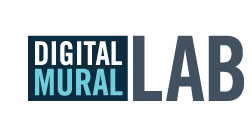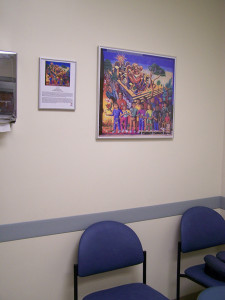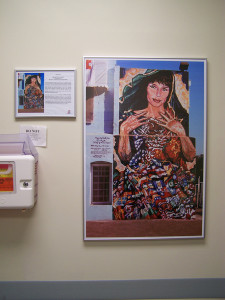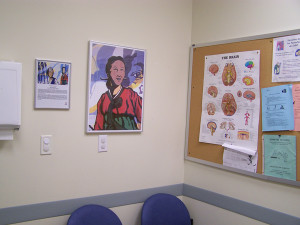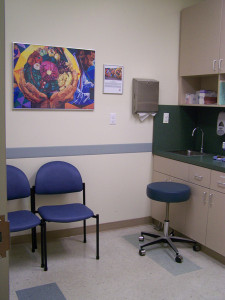SPARC murals find new life at Venice Family Clinic
BY GARY WALKER
Murals, which have a long and distinguished history in the rich social and cultural tapestry of Los Angeles, have different meanings for different people. Depending on what is being depicted, they can evoke conscious and subconscious emotions with their layered messages.
In an institution where healing and wellness are paramount, artwork can be important to a patient’s well-being, some healthcare professionals believe. For this and other reasons, two local organizations have joined forces to bring a bit of historical and esthetic perspective to a place where some of our city’s less fortunate turn to for their healthcare needs.
A joint venture between the Venice Family Clinic and the Venice-based Social and Public Art Resources Center, better known as SPARC, has resulted in an eclectic array of mural images on display at the clinic’s Santa Monica facility, the Simms/Mann Health and Wellness Center. SPARC, one of the nation’s foremost mural institutions, has reproduced 21 images from its vast archival vault that have decorated the walls of the center’s examination rooms since June, many of which now exist only in the nonprofit’s digital catalog. SPARC, led by Judith Baca, its founder and artistic director, has created an inspirational artistic landscape of socially conscious murals throughout the Los Angeles area for more than three decades, and while some of its murals are slowly disappearing, several have been revived through its recent partnership with the Venice Family Clinic. “It’s been a longtime dream of SPARC’s to partner with the Venice Family Clinic”, said SPARC executive director Debra Padilla in a recent interview. “We’ve been a part of their Artwalk for at least the last 20 years, and we’ve always wanted to have a deeper relationship with them.”
Two years ago, SPARC hosted a donor tour for the California Community Foundation with the clinic and the Venice Housing Corporation where the idea was broached about working together on a project that could be mutually beneficial to the two organizations. Out of that desire to collaborate came the Corazon Project, with SPARC providing images of their murals to the clinic, where the examination rooms now have a different look. “We’ve always considered them to be one of the stellar community organizations in Venice”, Padilla said. The opportunity came when they built a new building in Santa Monica which provides a critical service. But the space was esthetically bland. There was nothing that showed the heart, the spirit and the passion of what the clinic was providing to our community.
Initially, the areas that were considered were the reception area and the playroom, until SPARC representatives worked in conjunction with the clinic’s Patient Advisory Committee and eventually settled on the examination rooms. For Rio Diaz, SPARC’s gallery curator, selecting the images from the mural organization’s archives was an educational experience. “That’s what the murals have come to represent — educating the community”, Diaz said. All the messages about wellness, family education, community are infused in these images, and that was the primary selection process of finding these types of images. The images that were selected reflect the theme that Diaz described — health, wellness, education and family. “In the selection process, we specifically selected mural images that would be educational and inspirational for the patients, the staff and visitors to the clinic,” Diaz explained. “The plaques that accompany the images describe their story, because it’s important that there is narrative both in English and Spanish so that patients can take ownership of these murals as well as enjoy them.” Marcela Tetta, director for the Venice Family Clinic’s Simms/ Mann Health and Wellness Center programs, is grateful for SPARC’s mural images at the facility. “It’s a place of health and wellness, and although we do have sick patients, we want to promote prevention, health and wellness,” said Tetta. “Our funder, the Simms/Mann Family Foundation was very interested in making it a warmer place.” Tetta said that the goal was to represent the community with the clinic’s artwork, particularly because 80 percent of its patient base is minorities. “We wanted art that would speak to them, and SPARC’s murals really speak to our patients who are a part of the same community,” Tetta said.
Dr. Lucinda Gray, a clinical psychologist with an office in Playa de Rey, thinks that having imagery that conveys serenity is a welcome asset to a hospital or clinic setting. “These types of images can be very calming and relaxing, especially if the theme is healing,” said Gray. “It can be very nurturing to both doctors, nurses and patients to have these images in the examination rooms.” That sentiment is echoed by the clinic’s chief executive officer, Elizabeth Benson Forer.”Venice Family Clinic is more than a doctor’s office — it’s a medical home. So we want it to feel like a home”, Benson Forer told The Argonaut. “The SPARC murals are here to welcome our patients.” Tetta agrees. “I think that seeing high-quality artwork in an exam room that you can identify with is very empowering”, she said. Gray mentioned that images like those that have been created by SPARC muralists can be an instrumental component in creating an atmosphere of relaxation that can help patients who are depressed. “There are studies that have shown that very colorful images can affect emotion, and to many patients they can be very relaxing and stimulating”, ]the clinical psychologist noted.
While going through the images for the Santa Monica clinic, the project became a trip down memory lane for Diaz as she revisited signposts and markers from her childhood. “When you’re headed from one place to another in a car as a kid, you look out the window. And as I would see a certain mural, I would remember that I was close to my aunt’s house”, she recalled. “As I was going through them, I realized that I was also going through my life history, and I came to the realization how these images have been stamped in my memory. “I was going through a family album that was in my memory, and seeing these images everyday is a privilege for me and is something that I think that our community deserves to be educated about and to know its history.” For Tetta, the murals are inspirational. “I think for me, they represent who we are, and for a lot of children and young adults, I think they reflect hope and pride”, she said. Padilla also sees them as a personal and collective legacy. “I feel that these images are not only a gift to our community but to ourselves as well”, said SPARC’s executive director. “I feel that the pieces are in a good place.” This started in a very genuine way, and I feel very proud that we did this project.” Joining together with the Venice Family Clinic has been a special endeavor for both organizations, with the same goals in mind. “This partnership has deepened the belief of what healing should be about”, Padilla concluded. “We’re each doing that individually everyday, but collectively”, I feel that is a beautiful statement.
